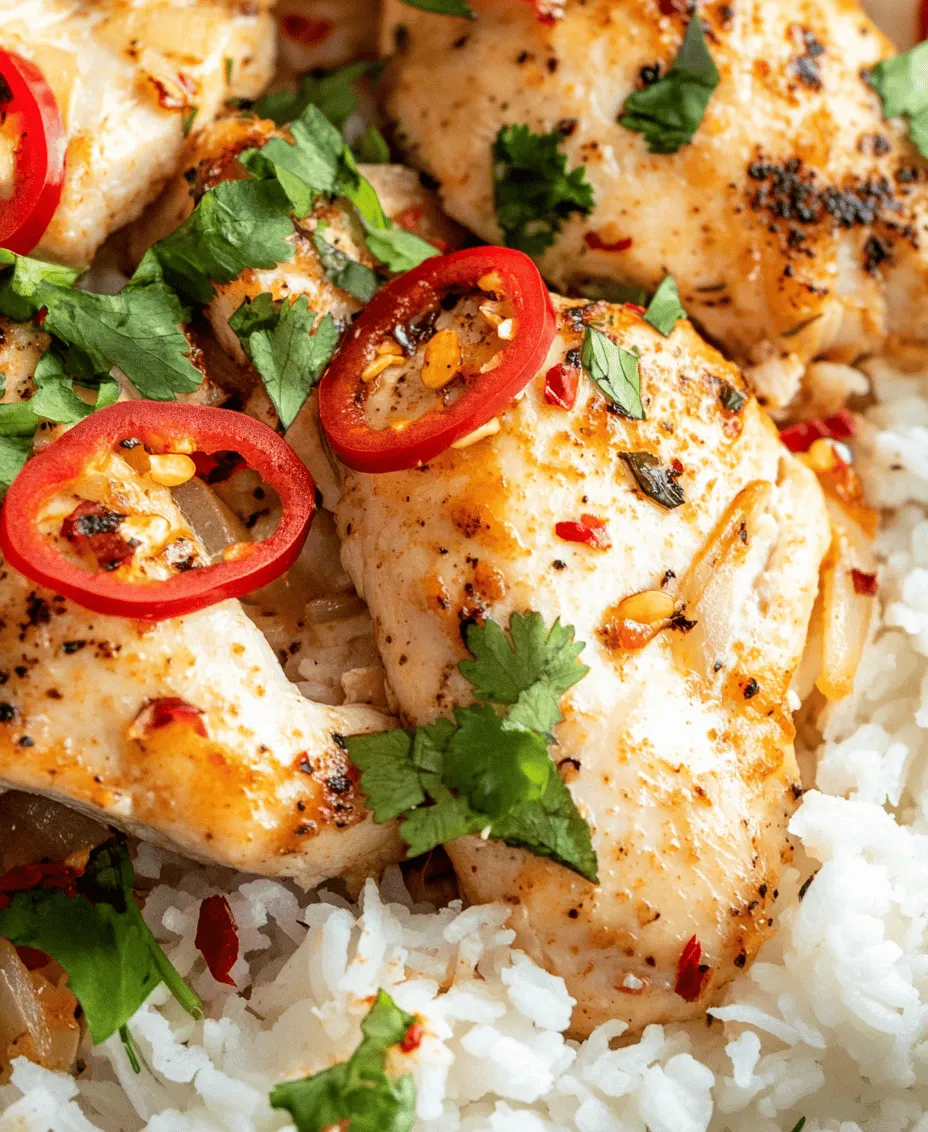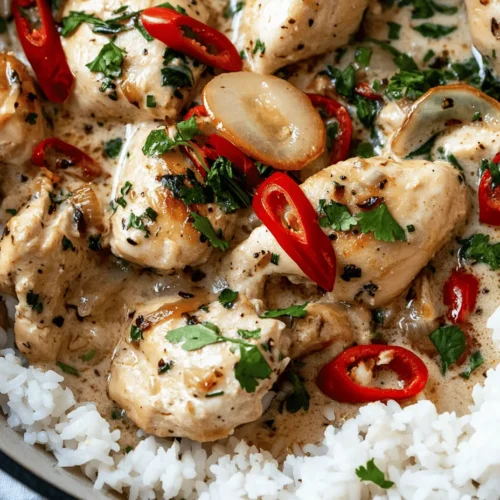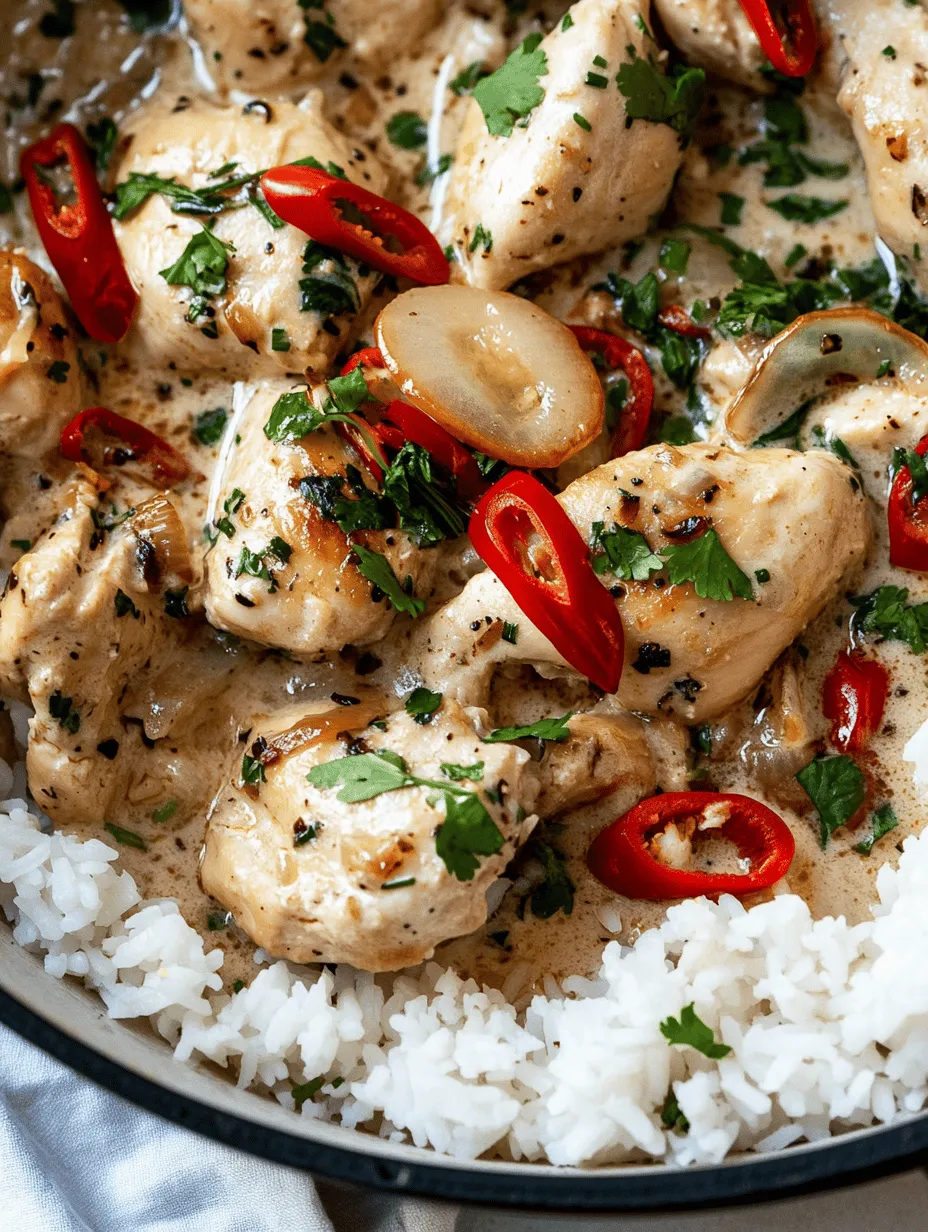Introduction
Brazilian cuisine is a vibrant tapestry woven from diverse cultural influences, reflecting the country’s rich history and regional variations. From the savory stews of the Amazon to the spicy seafood dishes of Bahia, Brazilian food is known for its unique combination of flavors, colors, and textures. One dish that truly embodies this culinary spirit is Spicy Brazilian Coconut Chicken. This dish showcases the quintessential elements of Brazilian cooking: fresh ingredients, bold spices, and a harmonious blend of flavors that dance on the palate.
Spicy Brazilian Coconut Chicken is a delightful representation of Brazil’s coastal cuisine, where coconut milk melds with spices to create a comforting and satisfying meal. This dish not only highlights the tropical essence of Brazil but also pays homage to its indigenous and African roots, making it a perfect choice for anyone looking to explore the depths of Brazilian flavors.
A cornerstone of authentic Brazilian recipes is the emphasis on using fresh ingredients and spices. The quality of these components can significantly impact the dish’s overall taste and authenticity. In this recipe, we will delve into the essential ingredients, the marination process, and the cooking techniques that will help you create a memorable Spicy Brazilian Coconut Chicken experience.
Understanding the Ingredients
To craft an exceptional Spicy Brazilian Coconut Chicken, it’s crucial to understand the key ingredients that contribute to its vibrant flavor profile. Each component plays a significant role in not only enhancing the taste but also in reflecting the essence of Brazilian cooking.
Chicken Thighs
The choice of chicken thighs in this recipe is intentional. Dark meat, such as thighs, offers a richer flavor and tenderness compared to white meat. The higher fat content in thighs helps to keep the chicken juicy throughout the cooking process, making it ideal for dishes that involve simmering in coconut milk and other flavorful liquids. In addition, chicken thighs are often more forgiving than breasts, retaining their moisture even if slightly overcooked.
Coconut Milk
Coconut milk is a staple in many Brazilian dishes, particularly in coastal regions where coconuts are abundant. It adds a creamy texture and a subtle sweetness that balances the heat from the spices. Beyond its culinary uses, coconut milk is also renowned for its health benefits, including healthy fats and vitamins that support overall wellness. Its richness complements the spices used in this dish, creating a luscious sauce that envelops the chicken and enhances its flavors.
Fresh Herbs and Spices
Aromatic herbs and spices are the backbone of Brazilian cuisine, contributing to the depth of flavor that characterizes many dishes. In Spicy Brazilian Coconut Chicken, garlic and onion form the aromatic base, providing a savory foundation. Chili peppers, often used in various forms, introduce the dish’s signature heat. The combination of these ingredients creates a fragrant and enticing aroma that enhances the overall dining experience.
Lime and Cilantro
The inclusion of lime and cilantro brings freshness and brightness to the dish. Lime juice adds acidity, which helps to balance the richness of the coconut milk and the spices, while cilantro contributes a burst of herby flavor. Together, they elevate the entire dish, making it not only flavorful but also refreshing. This balance of flavors is essential for creating a well-rounded and satisfying meal.
The Marination Process
Marinating the chicken is a crucial step that enhances the dish’s overall flavor and tenderness. A well-prepared marinade penetrates the meat, infusing it with spices and creating a depth of flavor that can elevate even the simplest chicken dish.
Ingredients for the Marinade
The marinade for Spicy Brazilian Coconut Chicken includes a blend of spices that are emblematic of Brazilian cuisine. Among these, smoked paprika plays a vital role. This spice adds depth and warmth to the dish, contributing a subtle smokiness that complements the sweetness of the coconut milk. Additionally, cumin and coriander are included for their earthy notes and aromatic qualities. These spices have origins in various regions, from the Middle East to South Asia, and they have found a beloved place in Brazilian cooking.
Suggested Marination Time and Tips
To achieve optimal results, it’s recommended to marinate the chicken for at least 30 minutes, although longer is even better. A marination time of several hours or overnight allows the spices to penetrate deeply into the meat, resulting in a more flavorful dish. If you’re short on time, a quick marinade will still provide good results; however, allowing the chicken to soak in the marinade will yield a more profound taste.
Here are a few tips for effective marination:
– Use a resealable plastic bag or a non-reactive bowl to ensure the marinade coats the chicken evenly.
– Ensure the chicken is at room temperature before marinating to allow for better absorption of flavors.
– If using wooden skewers for grilling, soak them in water for at least 30 minutes before cooking to prevent burning.
Cooking Techniques
The cooking techniques employed in preparing Spicy Brazilian Coconut Chicken are just as important as the ingredients themselves. Each method contributes to the dish’s final texture and flavor, ensuring that every bite is satisfying and delicious.
Searing the Chicken
Searing the chicken is a vital step that enhances its flavor. This technique involves cooking the chicken in a hot pan with oil until it develops a golden-brown crust. This not only adds a layer of texture but also creates rich, caramelized flavors that deepen the overall taste of the dish. To achieve a perfect sear, it’s essential to avoid overcrowding the pan, as this can cause the chicken to steam rather than brown.
Sautéing Aromatics
Once the chicken is seared, it’s time to sauté the aromatics. This involves cooking garlic, onions, and any other vegetables in the same pan to develop deeper flavors through caramelization. The fond (brown bits) left in the pan from searing the chicken can be deglazed with a splash of coconut milk or broth, lifting those flavors and incorporating them into the sauce. Properly sautéing the aromatics ensures that their flavors are fully released, resulting in a more complex and inviting sauce.
Managing Heat Levels
While cooking, it’s essential to manage the heat levels to retain moisture and flavor in the chicken. After searing and sautéing, reduce the heat to allow the chicken to simmer gently in the coconut milk. This slow cooking process helps to cook the chicken evenly while ensuring it remains tender and juicy. Adjusting the heat throughout the cooking process will prevent the sauce from boiling too vigorously, which can lead to tough chicken and a reduced sauce.
By following these initial steps and understanding the significance of each ingredient and technique, you will set the stage for creating a delicious Spicy Brazilian Coconut Chicken that captures the essence of Brazilian cuisine. This dish not only offers a culinary adventure but also invites you into the heart of Brazil’s rich and diverse flavors.

Creating the Coconut Sauce
To make the coconut sauce for your Spicy Brazilian Coconut Chicken, you’ll want to focus on layering flavors and achieving a creamy, rich consistency. Here’s a step-by-step guide to crafting this delicious sauce:
1. Sauté Aromatics: Start by heating a tablespoon of oil in a large skillet over medium heat. Add chopped onions, garlic, and ginger. Sauté until the onions become translucent and fragrant, usually about 4-5 minutes.
2. Add Tomato Paste: Stir in about 2 tablespoons of tomato paste. This ingredient is crucial as it adds umami and richness to the sauce, balancing the sweetness of the coconut milk. Cook the tomato paste for an additional 2 minutes to deepen its flavor and allow it to caramelize slightly.
3. Incorporate Coconut Milk: Gradually pour in 1 can (approximately 14 ounces) of coconut milk while stirring continuously to combine. The coconut milk should be full-fat for the best texture; it provides creaminess and a hint of sweetness that complements the spices beautifully.
4. Season the Sauce: Add your spices — typically, you’ll want to incorporate salt, black pepper, and cayenne pepper to taste. For an extra kick, consider adding a dash of smoked paprika or cumin. Stir well to incorporate all ingredients.
5. Achieve the Perfect Consistency: Allow the sauce to simmer on low heat for about 10-15 minutes. This simmering time is essential as it allows the flavors to meld and develop. If the sauce appears too thick, you can add a splash of chicken broth or water to reach your desired consistency.
6. Final Touches: Before combining the sauce with the chicken, taste and adjust the seasoning as needed. A squeeze of lime or lemon juice can enhance the overall flavor, bringing brightness to the dish.
Combining Flavors
Now that you have your coconut sauce ready, it’s time to integrate the chicken.
1. Add the Chicken: Once your chicken pieces are browned and partially cooked, pour the coconut sauce over them. Ensure that the chicken is well-coated in the sauce.
2. Simmer for Tenderness: Reduce the heat to low and cover the skillet. Allow the chicken to simmer in the coconut sauce for about 20-30 minutes. This process not only cooks the chicken through but also allows the meat to absorb the flavors of the sauce, resulting in tender and juicy pieces.
3. Check for Doneness: To ensure that your chicken is cooked through, use a meat thermometer to check the internal temperature; it should read 165°F (75°C). If you don’t have a thermometer, cut into a piece of chicken to ensure there’s no pink remaining.
4. Adjust Seasoning: Once the chicken is cooked, taste the sauce again. You may find that it needs a pinch of salt, a splash of vinegar, or an extra kick of spice. Adjust as necessary to achieve a balanced flavor profile that suits your palate.
Serving Suggestions
Spicy Brazilian Coconut Chicken is a versatile dish that pairs wonderfully with various sides. Here are some ideal accompaniments:
1. Traditional Rice Pairing: Serving this dish over a bed of fluffy white rice is a classic choice. The rice absorbs the rich coconut sauce, making each bite flavorful. Jasmine or basmati rice can also be great alternatives, adding a subtle fragrance.
2. Alternative Sides: If you’re looking for something different, consider serving the chicken over quinoa. Quinoa adds a nutty flavor and provides a protein boost. Steamed vegetables, such as broccoli or green beans, can add color and nutrients to your plate, complementing the richness of the dish.
3. Presentation Tips: To create a visually appealing presentation, serve the Spicy Brazilian Coconut Chicken in shallow bowls. Garnish with fresh cilantro or parsley for a pop of color. A wedge of lime on the side not only looks great but also allows guests to add a fresh burst of citrus to their serving.
Cultural Significance of Brazilian Cuisine
Brazilian cuisine is a tapestry of flavors influenced by indigenous, African, and European culinary traditions. Coconut and spices are integral to many dishes, particularly in coastal regions where coconuts thrive.
The use of coconut in this dish highlights its cultural significance in Brazilian cooking. It reflects the vibrant flavors and the diversity of ingredients available throughout the country. Spicy Brazilian Coconut Chicken showcases how various regions adapt this dish, with each adding unique spices or cooking methods that reflect local tastes.
For instance, in Bahia, you may find similar dishes featuring dendê oil (palm oil) and a variety of local peppers, showcasing the Afro-Brazilian influence. Each region of Brazil offers its take on this staple, making it a dish that celebrates the country’s rich culinary heritage.
Conclusion
In summary, Spicy Brazilian Coconut Chicken is not just a delicious meal; it is an experience that encapsulates the vibrant flavors and cultural richness of Brazilian cuisine. The interplay of spicy, sweet, and savory elements creates a dish that is both comforting and exotic.
As you explore this recipe, take the time to appreciate the ingredients and the cultural significance behind them. Cooking and sharing this dish with loved ones can foster connections and create lasting memories. Embrace the joy of cooking, and let the flavors of Brazil inspire you to delve deeper into its culinary traditions. Enjoy every bite!


